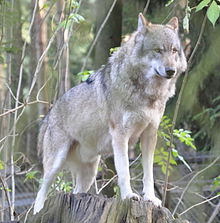
This might be my favorite post for this week. I love mythology, but am tired of movies and TV beating Greek and Norse mythology to death. They’re cool, but there are literally as many stories and characters as there are cultures on the planet. Below are 9 obscure Native American mythological characters and a brief summary of their stories. The pictures are a little off since these are generally pretty obscure. Enjoy.

9. Kee-Wakw
This is a monster from the folklore of the Abenaki people of the NE United States. The story claims in that in the days before colonization, this creature would prowl the woodlands of modern-day New England. It was a half man, half animal monster that cannibalized its victims. Not sure how it counts as cannibalism if the thing is a monster, but a pretty cool native american creature.
8. Amarok
This is an Inuit creation. Amarok is a giant wolf who prowls Central Alaska. They are said to travel in small packs of no more than three. The Inuit say that Amarok will hunt and kill any Inuit foolish enough to go hunting alone at night. This was clearly a story used to teach young hunters a valuable lesson.

7. Sosondowah
Sosondowah is an Iriqouis God who is known for helping the Goddess Dawn to catch a supernatural elk that she needed as a guardian. He is also known for the story of his love affair with Gendenwitha, a human girl. He sang to her as different birds each season and eventually tried to bring her to the sky. The Dawn would not allow this and took the girl and hung her on her door post. Supposedly she turned into the Morning Star. This way Sosonowah can always see her, but can never be with her.

6. Qalupalik
The Inuit have some pretty awesome myths, and the Qalupalik are no exception. They are said to be humanoids with scaly skin and long finger nails. You can hear them coming because of the low humming sound they are said to emit. The Inuit believed that these creatures would snatch up children who wandered to close to the water or disobeyed their parents and stuff them in a sack on the creature’s back. The Qalupalik would then keep the children underwater forever. In my opinion, this is way worse than the American boogey man.

5. Pahana
Hopi mythology is a complex system of deities and various realities. The Hopi believe in different eras of time which they call worlds. They believe that we are currently in the Fourth World. Pahana is known as the lost Hopi Brother and the Hopi believe that when he arrives he will smite the wicked and usher in the fifth world which will be a time of peace and happiness. Sounds a lot like Jesus to me, but this may not be as weird as it seems. Almost every mythology contains a sort of apocalyptic messianic figure (a future post, I guarantee it).

4. Quetzalcoatl
This guy, whose name I will not spell more than once, is a major Aztec deity and owner of a pretty cool power. He was believed to be able to turn himself into a winged serpent at will. There is very little known about this mythological figure, but there is one story I found. He was supposedly tricked into getting drunk and ended up sleeping with his sister the celibate priestess (again pretty biblical). When he discovers his actions, he (understandably) burns himself to death out of remorse. Kind of a Lot meets Oedipus if you ask me.

3. Hunahpú and Xbalanqué
These are two Mayan heroes who also happen to be twins. They appear in an ancient Mayan religious document known as the Popul Vuh. They are players of the Mayan ballgame just like their father and uncle who were killed after losing to the rulers of the Underworld. The boys were raised by their mother and grew to avenge their father and uncle. While their main story is about avenging their family, they are also featured fighting monsters and solving problems much like Hercules. Eventually the two brothers take to the skies where they become the Sun and the Moon. Not sure where these things were before these tow, but I guess you just have to let it slip and just enjoy the story.
2. Manco Capac
Manco is the mythical first emperor of the Incan civilization. He has many origin myths and is central to the Incan mythology. In one myth he is the son of the Fire god and arrives out of a cave with instructions to build a Sun Temple. In another, Manco is part of a powerful family that plans to unite their people and conquer the surrounding tribes. In this version, Manco is said to have ultimately betrayed his brothers and killed them for power. Regardless of which story is true, he is said to have ruled justly and abolished human sacrifice. He also was known for creating the Incan law code. A great example of a western mythological motif showing up in pre-Columbian native stories.
1. Kooshda
The final Inuit character. The Koosha were said to be half man and half otter creatures. They seem to have cohabited with people at one time, but have a nasty trick up their sleeve. If they are able to drown you, then you turn in to one of them and have to go live in their lair. However, if they save you from drowning you become their human servant and gain the power to shape shift and pursued people. Not a bad gig if your otter person overlord is an ok guy.
Thanks for reading one of my favorite lists. For more on mythology and religion check out 7 Strange Moments in the Bible, 9 Gods of the Egyptian Pantheon and 8 Haunted Places from Around the World.




It’s interesting, because the Kooshda of the Inuit are not the only occurrence of this exact same creature in the North American indigenous world. There are several other occurrences as well, and in fact are involved in one story about a character’s rise to manhood during his pilgrimage.
LikeLike
The number of reoccurring characters across all of the Native American mythologies is fascinating. Thanks for the comment and hope you can read some of the new material being published.
LikeLike